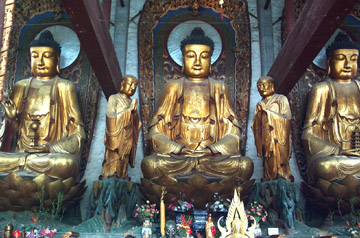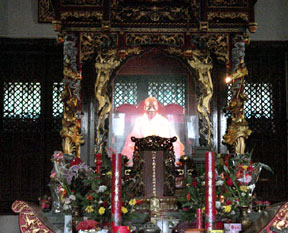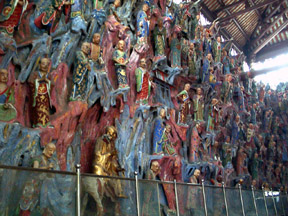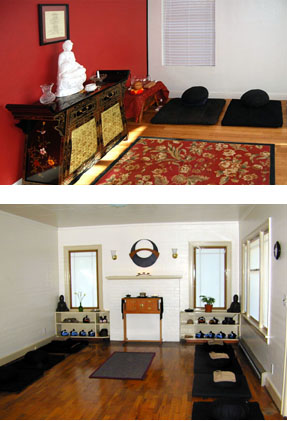"Sometimes I'd go to see old religious sites with ancient temples. In some places they would be cracked. Maybe one of my friends would remark, "Such a shame, isn't it? It's cracked." I'd answer, "If they weren't cracked there'd be no such thing as the Buddha. There'd be no Dhamma. It's cracked like this because it's perfectly in line with the Buddha's teaching."
A visit to Nan Hua monastery in China, founded by our sixth and last Chan patriarch, Hui Neng, will leave most any westerner pondering over the many obvious differences between Zen Buddhism as it's presented in its birthplace country, and as it's presented here in the West. Visitors to this or, in fact, any other Buddhist monastery in China, will observe Chan monks chanting, bowing, praying and performing elaborate rituals.  They will observe a variety of beautiful religious art motifs: gilt statues of the Buddha, ornate shrines, and various Buddhist iconography. [FN-1] They will hear monks and nuns singing lyrical chants and relish the refined scents of sandalwood incense.
They will observe a variety of beautiful religious art motifs: gilt statues of the Buddha, ornate shrines, and various Buddhist iconography. [FN-1] They will hear monks and nuns singing lyrical chants and relish the refined scents of sandalwood incense.
On the other side of the globe, without the ancient establishment of Buddhism as it exists in China, many of their Western counterparts make do with little: they may do no more than put a rock and a vase of flowers on a table and bow in prayer to the Buddha image in their mind. Practitioners or leaders of Zen groups who may not have a complete understanding of the relationship between Zen and Buddhism may tend to confuse and/or alienate people by presenting a single-sided or otherwise incomplete perspective. They may also fail to recognize that Zen practice, unbalanced by Buddhist moral precepts, is stark and difficult to navigate. As a result of the frequent disconnect between Zen and Buddhism, the West has seen its share of notorious Zen Leaders[FN-2] which has led many western Zen groups to become wary of the Buddhist religious establishment altogether, preferring to isolate Zen from its Buddhist roots even further. In fact, some groups have gone so far as to advertise themselves proudly as being "priest-free," as if they had eliminated a dangerous toxin from their midst.
 Perhaps Buddhism in the west is cracked, but is this cause enough to discard it altogether?
Perhaps Buddhism in the west is cracked, but is this cause enough to discard it altogether?
In a recent essay series we addressed some of the challenges facing western Buddhism (see Western Zen: Transition and Turmoil) but addressing the challenges hardly solves the problems. When we isolate Zen from its Buddhist roots, it's like cutting off the head and leaving the body behind as if it was of no value. The brain separated from its heart can't function properly.
It’s not surprising that the austere, sometimes cold and punishing approach to Zen, often experienced at Western zendos, lead many to turn away from Zen. Rejecting the whole concept of Zen they seek another path or return to their former religious tradition, simply for the familiar comfort of belonging. People expect their religious practice to be a beautiful experience that will bring them joy. Where there is no joy, no beauty, there’s no attraction. Where there is no attraction, there is no refuge, nor hope for salvation.[FN-3] Because spiritual disciplines, like Zen, are so difficult, especially in the beginning, it is the spiritual refuge of the religion that helps us endure the hardships. If there is no refuge, no sanctuary for the heart, the discipline becomes nothing more than endurance.
 Although some of us can be perfectly happy sitting on a rock in meditation without the need for the religious accouterments of Buddhism to bring joy into our lives, what of those of us who are new to Zen Practice? What of those of us who can’t so easily see perfection in a rock and vase alone together on an alter table? What of those of us who are not yet ready for the discipline of Zen but are nonetheless seeking that path that will lead us there? This is the beauty of Buddhism, the religion. It offers a welcoming, inviting, door to everyone, at any stage on the spiritual journey. Unfortunately, we can’t always say the same for Western "sanitized" Zen. When people move away from Zen because it lacks heart, or when they’re not ready for discipline that lacks sanctuary, where are they to go?[FN-4] When we sever the Buddhist link from Zen, there’s nowhere for the spiritual seeker to go but to another religion … or worse, nowhere at all. This is a disservice to humanity and a penalty for having severed Zen from its Buddhist roots: for importing only a select piece of the religion while neglecting the whole. [FN-5]
Although some of us can be perfectly happy sitting on a rock in meditation without the need for the religious accouterments of Buddhism to bring joy into our lives, what of those of us who are new to Zen Practice? What of those of us who can’t so easily see perfection in a rock and vase alone together on an alter table? What of those of us who are not yet ready for the discipline of Zen but are nonetheless seeking that path that will lead us there? This is the beauty of Buddhism, the religion. It offers a welcoming, inviting, door to everyone, at any stage on the spiritual journey. Unfortunately, we can’t always say the same for Western "sanitized" Zen. When people move away from Zen because it lacks heart, or when they’re not ready for discipline that lacks sanctuary, where are they to go?[FN-4] When we sever the Buddhist link from Zen, there’s nowhere for the spiritual seeker to go but to another religion … or worse, nowhere at all. This is a disservice to humanity and a penalty for having severed Zen from its Buddhist roots: for importing only a select piece of the religion while neglecting the whole. [FN-5]
 D. T. Suzuki, likely the most prolific writer to date on Japanese Zen for western audiences, often said that Zen could be adopted by any religion: we could have a Christian Zen, a Jewish Zen, a Muslim Zen, etc. Zen did not, he said, have to be part of Buddhism, but could just as well be fully independent of it, to the extent, even, that you could attach it to anything you liked. Not surprisingly, we have not heard this view expressed in China where Chinese Chan, being tightly integrated into Buddhism, is offered to all (if only embraced by the few), and where the notion of Zen being independent of Buddhism has not had the need to be considered.
D. T. Suzuki, likely the most prolific writer to date on Japanese Zen for western audiences, often said that Zen could be adopted by any religion: we could have a Christian Zen, a Jewish Zen, a Muslim Zen, etc. Zen did not, he said, have to be part of Buddhism, but could just as well be fully independent of it, to the extent, even, that you could attach it to anything you liked. Not surprisingly, we have not heard this view expressed in China where Chinese Chan, being tightly integrated into Buddhism, is offered to all (if only embraced by the few), and where the notion of Zen being independent of Buddhism has not had the need to be considered.
As if in response to Suzuki's remarks, there are now movements to integrate Zen into other religions. While this can lead to beautiful new and refreshing spiritual approaches to otherwise "stale" ones, significant challenges arise when trying to integrate Zen's spiritual path into pre-existing religious theologies and practices: neither good nor bad, it simply creates a new "thing" - a "thing" that becomes no longer Zen, nor any longer the religion that adopted it. This speaks, perhaps, of a spiritual void in people's lives that's not being filled by their religious traditions. And it speaks of a lack of qualified, experienced, spiritual leaders who can connect people with the higher spiritual paths of their own religion. All the major world religions have their own ancient mystical approaches, different in appearance but not in substance, from Zen. They have the added benefit of being already integrated with their parent religion; for example, Judaism has the Kabalistic practices [FN-6], Islam has Sufism,[FN-7] and Christianity has Christian Mysticism. [FN-8] Although it is true that Zen meditative practices, presented apart from Buddhism, can connect with people of all religions, it is within the context of their religions that they find the value of the meditative practice. Without this connection to these religions the practice is as barren as it is without its original face.
 As westerners brought up in different religious traditions and cultures, we won't ever have the same Buddhism as the Chinese, the Japanese, the Koreans, or the Vietnamese. Nor should we. Our psyches are shaped by western cultures, not eastern ones. A religion will invariably speak uniquely to each culture that adopts it, but is there value in abandoning the core foundation of a spiritual tradition? Giving thanks to the ocean that supports the boat we ride in, acknowledging and honoring the great progenitors of Chan who have kept it alive for centuries through the institution of Buddhism, is a beautiful thing. The truth is, we wouldn't have Zen without Buddhism. When we westerners finally come to accept the sensibility of integrating Buddhism, the religion, with Zen, its mystical path, rather than encouraging a rift between them, both become stronger, both become whole: the heart and the brain will re-connect and once again work harmoniously together.
As westerners brought up in different religious traditions and cultures, we won't ever have the same Buddhism as the Chinese, the Japanese, the Koreans, or the Vietnamese. Nor should we. Our psyches are shaped by western cultures, not eastern ones. A religion will invariably speak uniquely to each culture that adopts it, but is there value in abandoning the core foundation of a spiritual tradition? Giving thanks to the ocean that supports the boat we ride in, acknowledging and honoring the great progenitors of Chan who have kept it alive for centuries through the institution of Buddhism, is a beautiful thing. The truth is, we wouldn't have Zen without Buddhism. When we westerners finally come to accept the sensibility of integrating Buddhism, the religion, with Zen, its mystical path, rather than encouraging a rift between them, both become stronger, both become whole: the heart and the brain will re-connect and once again work harmoniously together.
There's little doubt that someday there will be a culturally unique "Buddhism of the West," but how this process will unfold there's no way to know. Buddhism required over five centuries to become a mature religion in Japan. In the West it's still in its first century. Will Zen Buddhism become a mixture of Jewish, Christian, and Hindu mysticism along with Japanese, Chinese and Korean Zen? Religious iconography is filled with Self-symbolism and all mature religions have evolved representations of them, inspired by archetypal encounters we all have on the spiritual journey. How will these universal motifs of Self (and it's fragments) be represented in future Western Zen art? For the Messiah, or celestial savior figure, will we have a Chinese-looking Maitreya (Mithras), a Greek-looking Dionysus, an Indian-looking Krishna? How will we envision these universal religious motives that arise from the collective unconscious -- those fragments of Self that seek to be known? Inevitably, our own collective spiritual lives will guide the evolution of Western Buddhism.
 Albert Einstein, that great twentieth century icon of Western culture and wisdom, showed great hope for Buddhism as leading toward a universal world religion, a religion that could, in its ideal form, equally embrace all aspects of human awareness and understanding, both spiritual and intellectual. He wrote:
Albert Einstein, that great twentieth century icon of Western culture and wisdom, showed great hope for Buddhism as leading toward a universal world religion, a religion that could, in its ideal form, equally embrace all aspects of human awareness and understanding, both spiritual and intellectual. He wrote:
"The religion of the future will be a cosmic religion. It should transcend personal God and avoid dogma and theology. Covering both the natural and the spiritual, it should be based on a religious sense arising from the experience of all things natural and spiritual as a meaningful unity. Buddhism answers this description ... If there is any religion in the world that could cope with modern scientific needs it would be Buddhism."
Cracked as it may be, Buddhism speaks to the heart and mind and soul through its imperfections as well as its perfections. Yet perhaps it is its very imperfection that appeals most to many of us; its lack of absolute answers to infinite questions that stimulates the imagination and turns our attention inward toward our Self-Nature. Perhaps it is its ability to keep us off balance - to not let us get too comfortable lest we get lazy and stop inquiring and searching. Perhaps it's the cracks themselves that are such a valuable companion to Zen.
Footnotes
FN-1 For more information on Chinese art and symbolism, see Outlines of Chinese Symbolism & Art Motives, by C.A.S Williams, Buddhist Art and Architecture, by Robert E. Fisher, A Dictionary of Chinese Symbols, Hidden Symbols in Chinese Life and Thought, by Wolfram Eberhard, and The Art of Zen, by Stephen Addiss.
FN-2 The reader interested in pursuing this topic further may wish to read Zen at War by Brian Daizen Victoria, The Sacred Canopy, by Peter L. Berger, Shoes Outside the Door by Michael Downing, and The Zen Master in America: Dressing the Donkey with Bells and Scarves, by Stuart Lachs.
FN-3 Salvation is the ultimate purpose of all religions. Salvation, to a Zen person, is what happens when we shed our ignorance of our true nature, our Buddha Self. The process recovers our humanity and illuminates our full identity as a human being. Zen's ox herding photos are considered by many to be a quintessential representation of the spiritual path of Zen, and equally representative of all spiritual paths.
FN-4 Beginning Zen students may find themselves immersed in nightmares, fearful visions, anger, depression, or a host of other difficult emotional situations. This occurs normally, to varying degrees, during beginning Zen training as subconscious contents that were buried in the past bubble up into consciousness. An unprepared beginning student of Zen, or one without the good fortune of an experienced mentor to work with, may become psychotic or develop other serious psychological syndromes. It is important to know when to stop Zen practice and return to preparatory disciplines.
FN-5 Dr. Scott Peck and James Fowler wrote prolifically about the stages of spiritual growth that seem to be universal to the human psyche and spirit. The interested reader may enjoy reading Stages of Faith: The Psychology of Human Development, by James Fowler, The Different Drum, by M. Scott Peck, MD, and Coming Home, The Experience of Enlightenment in Sacred Traditions by Lex Hixon. Also see, Man and Transformation, Papers from the Eranos Yearbooks, edited by Joseph Campbell.
FN-6 e.g. cf., Kabbalah, The Way of the Jewish Mystic, by Perle Epstein, and Zohar, The Book of Enlightenment, Edited by Daniel Chanan Matt.
FN -7 e.g. cf., Ibn 'Ata' Illah the Book of Wisdom/Kwaja Abdullah Ansari Intimate Conversations, by Victor Danner, Wheeler M. Thackston, and Annemarie Schimmel, and Teachings of Rumi, The Masnavi, Abridged and translated by E.H. Whinfield.
FN-8 e.g. cf., The Collected Works of St. John of the Cross, translated by Kieran Kavanaugh, O.C.D. and Otilio Rodriguez, O.C.D., and Wisdom of the Desert, by Thomas Merton.
